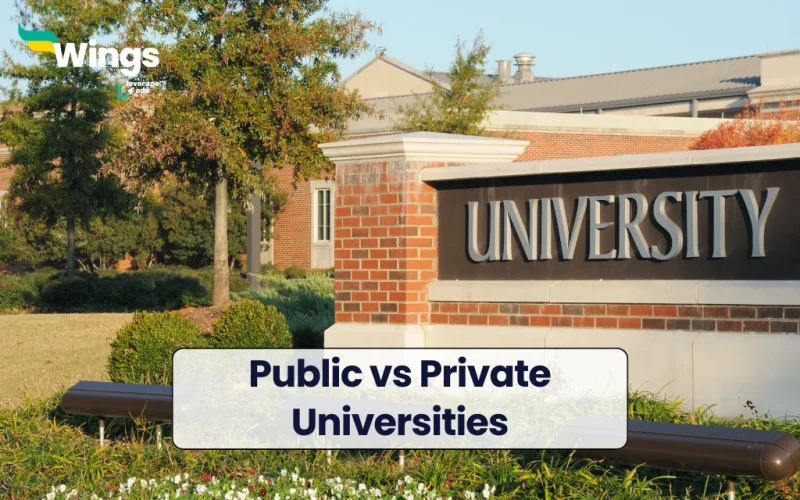Deciding where to pursue higher education is one of the most significant choices an international student will make. The landscape of universities globally broadly divides into two main categories: public universities, like the University of California – Berkeley, UCLA, and Germany’s Technical University of Munich (which often has minimal fees), are typically government-funded, leading to lower tuition (e.g., USD 25,000-USD50,000 annually in the US for out-of-state) and private universities such as Harvard, Stanford, and India’s Manipal Academy of Higher Education, are privately funded, generally resulting in higher tuition (e.g., USD 25,000-USD 80,000+ annually in the US, INR 1.5-20+ lakhs in India). Both offer unique advantages and disadvantages, and understanding these distinctions is important to making an informed decision that aligns with your academic aspirations, financial situation, and personal preferences.
This detailed blog will delve into the characteristics, benefits, drawbacks, and typical costs associated with each, highlighting top public vs private universities worldwide to guide your selection process.
This Blog Includes:
Main Difference Between Public vs Private Universities
When deciding between a public vs private university, international students need to consider various factors beyond just the cost. This table breaks down the important differences and what they mean for your academic journey and overall experience abroad.
| Feature | Public Universities | Private Universities |
| Funding Source | Primarily state or national government funding | Primarily tuition fees, endowments, and private donations |
| Tuition Fees | Generally lower, especially for in-state students; higher for international/out-of-state but usually less than private | Generally higher |
| Class Size | Typically larger, especially for introductory courses; less individualized attention | Typically smaller, more personalized attention |
| Program Variety | Broader range of programs across many disciplines; often emphasize practical/widely applicable degrees | Can be specialized or offer niche programs; may focus on liberal arts or specific fields |
| Financial Aid & Scholarships | Often rely on government aid programs; institutional scholarships for international students may be less extensive | Often have more substantial institutional scholarships and grants (merit-based & need-based) due to larger endowments |
| Student Body | Generally larger and very diverse | Typically smaller and can be more selective; diversity varies widely |
| Campus Culture | Often vibrant and bustling; wide range of activities and large-scale events; less exclusive | Often closer-knit community; more intimate social scene; culture may be more specialized/focused |
| Research Focus | Many are leading research institutions with extensive facilities and opportunities | Many also have strong research focuses, often within specialized areas |
| Bureaucracy | Can sometimes have more complex administrative processes due to larger scale | Often more streamlined administrative processes due to smaller scale |
Meaning of Public University
A public university is a higher education institution primarily funded and operated by a state or national government. This government backing allows them to offer generally lower tuition fees to students, including international ones (though often at a higher “out-of-state” rate), compared to private universities. These institutions typically serve a broad public mission by providing accessible education, often featuring larger student bodies, a wide array of academic programs, and extensive research opportunities due to their scale and public mandate.
Here’s a table showcasing some of the top public universities across various countries, along with their average annual tuition fees for international students. Please note that these fees are estimates and can vary significantly based on the specific program (undergraduate, postgraduate, specific major), and are exclusive of living expenses.
| Public University Name | Country | Average Annual Tuition Fees |
| University of California, Berkeley | USA | ~45,000 – 48,000 USD |
| University of California, Los Angeles (UCLA) | USA | ~43,000 – 48,000 USD |
| University of Michigan – Ann Arbor | USA | ~58,000 – 65,000 USD |
| University of Texas at Austin | USA | ~35,000 – 55,000 USD |
| Purdue University | USA | ~20,000 – 30,000 USD |
| University of Toronto | Canada | ~37,000 – 43,000 CAD |
| McGill University | Canada | ~12,000 – 55,000 CAD |
| University of British Columbia | Canada | ~38,000 – 45,000 CAD |
| University of Ottawa | Canada | ~24,000 – 35,000 CAD |
| Technical University of Munich (TUM) | Germany | ~€0 – €6,000 per semester (plus semester fees) |
| Ludwig Maximilian University of Munich (LMU) | Germany | ~€0 – €300 per semester (plus semester fees) |
| Heidelberg University | Germany | ~€0 – €1,500 per semester (plus semester fees) |
| Australian National University (ANU) | Australia | ~28,000 – 55,000 AUD |
| University of Melbourne | Australia | ~30,000 – 60,000 AUD |
| University of Sydney | Australia | ~25,000 – 55,000 AUD |
| University of Oxford | UK | ~29,000 – 48,000 GBP |
| University of Cambridge | UK | ~29,000 – 48,000 GBP |
| The University of Edinburgh | UK | ~25,000 – 40,000 GBP |
Meaning of Private University
A private university is a higher education institution that operates independently of direct government funding. Unlike public universities, which rely heavily on state or national government support, private universities primarily generate their revenue through student tuition fees, endowments (large sums of money donated and invested), and private donations from alumni, foundations, and other benefactors. This funding model gives them greater autonomy in their operations, curriculum design, admission criteria, and tuition rates, often leading to a focus on specialized programs, smaller class sizes, and a more personalized learning environment.
Here’s a table showcasing some of the top private universities across various countries, along with their average annual tuition fees for international students.
| Private University Name | Country | Average Annual Tuition Fees |
| Massachusetts Institute of Technology (MIT) | USA | ~62,000 – 65,000 USD |
| Stanford University | USA | ~65,000 – 70,000 USD |
| Harvard University | USA | ~54,000 – 90,000 USD |
| California Institute of Technology (Caltech) | USA | ~60,000 – 64,000 USD |
| Yale University | USA | ~67,000 – 85,000 USD |
| University of Chicago | USA | ~60,000 – 70,000 USD |
| The King’s University | Canada | ~15,900 – 17,700 CAD |
| Quest University Canada | Canada | ~35,000 CAD |
| Yorkville University | Canada | ~31,800 – 35,300 CAD |
| Trinity Western University | Canada | ~23,000 – 47,500 CAD |
| London School of Economics and Political Science (LSE) | UK | ~25,000 – 30,000 GBP |
| Imperial College London | UK | ~29,000 – 36,000 GBP |
| University College London (UCL) | UK | ~25,000 – 34,000 GBP |
| Bard College Berlin | Germany | ~20,000 – 25,000 EUR |
| Constructor University | Germany | ~18,000 – 22,000 EUR |
| Hertie School | Germany | ~20,000 – 35,000 EUR |
| Torrens University Australia | Australia | ~13,200 – 34,480 AUD |
| Australian Catholic University | Australia | ~18,944 – 41,472 AUD |
| Manipal Academy of Higher Education (MAHE) | India | ~₹1.5 Lakh – ₹20 Lakh INR |
| BITS Pilani | India | ~₹2.5 Lakh – ₹25 Lakh INR |
| VIT Vellore | India | ~₹2.2 Lakh – ₹15 Lakh INR |
| Amrita Vishwa Vidyapeetham | India | ~₹4 Lakh – ₹10 Lakh INR |
Also Read: Public vs Private Universities in USA
Similarities Between Public vs Private Universities
Despite their different funding models, public and private universities share core objectives and operational aspects. This table highlights their important similarities between public vs private universities:
| Feature | Description |
| Accreditation & Recognition | Both types of institutions adhere to rigorous accreditation standards set by recognized national or regional bodies, ensuring program quality and degree legitimacy. Degrees from accredited institutions of either type are equally recognized by employers and for further education globally. |
| Academic Standards & Rigor | Both are committed to providing high-quality higher education. They generally follow similar academic structures (e.g., credit systems, grading standards) and emphasize critical thinking, research skills, and independent learning. |
| Research & Scholarship Focus | Many universities, regardless of funding type, prioritize research and scholarly activities. They encourage faculty research and often provide opportunities for students to engage in cutting-edge projects. |
| Student Support Services | Both offer a comprehensive range of essential services for student success and well-being, including academic advising, career counseling, mental health services, disability support, and international student offices. |
| Extracurricular Activities | Both provide numerous opportunities for extracurricular involvement, such as student clubs, organizations, sports teams, arts groups, and volunteer initiatives, fostering holistic student development. |
| Alumni Networks | Both cultivate alumni networks that serve as valuable resources for current students and graduates, offering mentorship, networking opportunities, and career connections. |
| Preparation for Future | Both aim to equip students with the necessary knowledge, skills, and connections to successfully pursue their chosen careers or further academic studies (e.g., graduate school). |
| Facilities & Resources | Both invest in and maintain modern facilities like libraries, laboratories, lecture halls, and recreational spaces. They also extensively integrate technology into teaching, learning, and campus operations. |
| Faculty Expertise | Both strive to attract and retain highly qualified faculty members who are experts in their respective fields, contributing to both teaching and research. |
| International Student Support | Both typically have dedicated international student offices to assist with visa processes, immigration regulations, cultural adjustment, and support services tailored for non-domestic students. |
Also Read: Private Universities in Australia
Private vs Public College/University: Pros and Cons
Many students ask about the benefits of public universities over private universities. So, when you google the differences between public vs private universities, the most common criteria of distinction is that of funding. Public colleges and universities get their funding from the government, be it state or central, while private universities have tuition fees, business houses, private investors, founders, etc. as the key source of funding. If you are looking for the pros and cons of private vs public college or university, there is no straight answer. As a student, you need to consider some major parameters to weigh down their pros and cons such as:
- First list down your preferred private or public college/university and their programs that you are interested in.
- Then, assess each university as per their course curriculum, industry visits, training opportunities, infrastructure, industry exposure and faculty, amongst others.
- Many public universities offer lucrative scholarships while private universities have limited financial aid options.
- Get in touch with the alumni of your chosen public vs private university/college and ask for their insights on the pros and cons of attending the university or college of your preference.
How to Choose Between Public vs Private Universities: Which is Better?
To choose between public vs private universities, various parameters should be considered before making the final decision. In the segment below, various parameters have been mentioned separately which are the major points of difference between both the types of universities. It will help provide an overview of how to choose a proper university type for a prospective student satisfying all their needs.
Educational Costs
Public Universities charge less tuition fees but the selection criteria to get accepted into these universities can be difficult due to high competition. On the other hand, private universities charge a higher tuition fee, but selection criteria are more flexible. Even though government-funded schools are supported through state and bureaucratic projects, they at times can charge an astronomical amount whilst some private schools charge a reasonable amount looking at the caliber of the student and their probability of excelling.
Campus Size and Culture
A few people flourish in a loud, swarmed condition, while others incline toward a peaceful and comfortable environment that isn’t overpowering and thus a campus size can play a gigantic role in choosing the correct institution. Numerous public universities have a bigger campus to be able to accommodate a huge student body. Private schools pride themselves on their diversity while still having a smaller, more private campus. It depends on the choice of the student and the environment they find conducive for learning and to be able to leverage their strengths.
Scholastics and Acceptance Rate
Most of the private schools, particularly if they are an Ivy League institution have tough scholastic and acceptance guidelines. A prospective student is required to meet all their prerequisites and once accepted into the school a student is required to keep up to their high scholarly principles. Public universities have fewer requirements when compared to private universities and more flexible admission criteria.
Also Read: List of Indian Universities Tie Up with Foreign Universities
FAQs
Public universities charge a lower fees than private universities across the world which makes the former a better option. However, it is best to judge every college across several parameters and take all facts into consideration before accepting an offer.
Public Universities charge lower tuition fees but are also extremely competitive and have a low acceptance rate.
Private Universities are an excellent choice for higher education, though, the tuition fee is higher, they offer financial aid to need-based students. Some of the best universities like Harvard, Princeton, Stanford universities are private-run higher education institutions.
The USA has over 4000 universities and some of its best universities like Harvard, Yale, UCB, Johns Hopkins are a mix of both private and public universities. Depending upon personal preference, tuition cost, course details and future prospects one should decide their college.
RELATED BLOGS
We hope this blog gives you a complete overview of Public vs Private Universities for International Students. Stay tuned to Leverage Edu for more such content on student life abroad. Thank you for reading!
-
Thank you for sharing with us your Content is awesome and informative.
-
Thank you!
-
-
Which university is best in kolkata for BBA
-
Hi, Mushkan! Below are some of the top colleges of BBA in Kolkata.
Bhawanipur Education Society College, Kolkata
JDBI Kolkata
The Heritage Academy, Kolkata
Future Institute of Engineering and Management, KolkataFor more help, ring us at 1800 57 2000!
-

 One app for all your study abroad needs
One app for all your study abroad needs





















 60,000+ students trusted us with their dreams. Take the first step today!
60,000+ students trusted us with their dreams. Take the first step today!


4 comments
Thank you for sharing with us your Content is awesome and informative.
Thank you!
Which university is best in kolkata for BBA
Hi, Mushkan! Below are some of the top colleges of BBA in Kolkata.
Bhawanipur Education Society College, Kolkata
JDBI Kolkata
The Heritage Academy, Kolkata
Future Institute of Engineering and Management, Kolkata
For more help, ring us at 1800 57 2000!